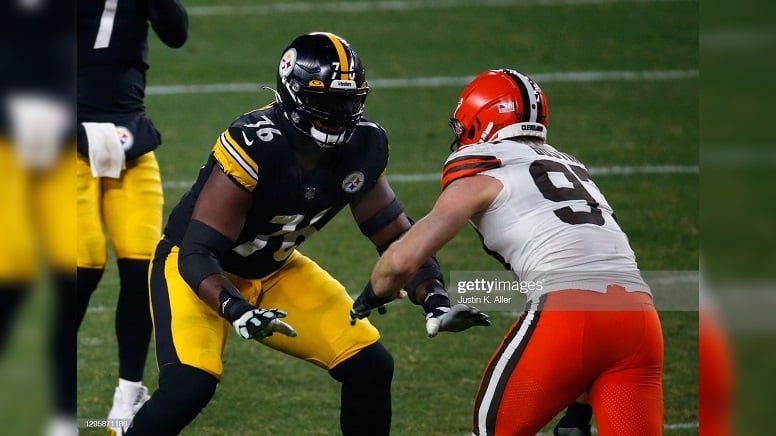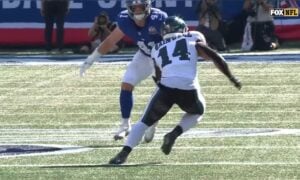The Pittsburgh Steelers certainly have a lot of questions about their rebuilt offensive line heading into the 2021 season. One of those revolves around fourth-year tackle Chukwuma Okorafor switching from the right to left side. With Okorafor primarily being a left tackle in college his final two years at Western Michigan, many are wondering if he might become a better player in 2021 with a switch back to what many believe to be his more natural side.
On Tuesday, former Steelers tackle Max Starks was a guest on 93.7 The Fan. During his interview he was asked about the plausibility of Okorafor maybe being a better player in 2021 now that he’s set to return to the left tackle spot after playing his first three seasons in the NFL at the right tackle position. Starks’ answer, while long, included a lot of great information on the subject.
“Yes, I can make it nice and easy,” Starks said. “Most people are right-handed, right? When you’re writing your name on a piece of paper, you write your name, boom, comes off easy. You ask somebody to switch hands and put the pencil in their left hand, it’s a lot tougher. You’re focusing a lot more on how you’re going to, in my case, write an ‘M’ against the grain on how you’re used to writing the ‘M.’ That’s what it is being a right tackle to if you’re naturally a left tackle and vice versa. You have to switch things over in your mind. And if you’re a right-handed dominant or a left-handed dominant person, that’ll also play into your ease and comfort. And I think for Chuks the biggest thing is if he feels more comfortable, if that biomechanics of having one leg up, the other one back and you moving and your hips fitting into that space, it’s going to be a big difference.”
That wasn’t the end of Starks’ great detail on the topic of switching sides, however. He went on to explain why some players might struggle when asked to play on a side of an offensive line they maybe aren’t really familiar with.
“I think that’s why you see a lot of guys struggle in the transition if they’re not naturally one side or the other, it’s more forced,” Starks said. “It’s like you’re trying to study for this constant test that you don’t know when it’s going to happen and you’re fighting yourself and you’re using way more energy to make sure that you stay on path versus something being natural, something being easy to do. I mean, think about a child, right? The first time a child picks up a pencil and starts to write, it’s a chore. But now if you do it at age 25, 26, and you pick up a pencil, you’re going to write immediately, you’re going to boom, boom, boom down the page, no matter what it is. And so, it’s the same thing is that for Chuks, he’s been a left tackle, but he wanted to get on the field, so he switched to right tackle, and you have to learn. It takes more issues that you might not look as smooth, as natural as he would if he’d have been a right tackle coming into the league.”
After that long detailed description, Starks, who made the move from right tackle to left tackle during his long NFL career with the Steelers, sounded like he’s hopeful that a move to his more natural left side might ultimately work out well for Okorafor in 2021.
“And so, for Chuks, it’s going to be interesting,” Starks said. “I’m hoping for the best because I know, like you said, I did it before. You know, I was naturally a left tackle, but I learned to play right tackle and thank goodness during my college career I played both, so I still had the familiarity. But now guys are being so specialized that a left tackle is a left tackle is a left tackle and a right tackle is a right tackle is a right tackle, maybe even a guard.”
As part of him wrapping up his thoughts on the topic, Starks gave a recent example of a high pedigree tackle switching sides as a rookie.
“And so, you know, one of the classic examples, look at Jedrick Wills for the [Cleveland] Browns,” Starks said. “You know, he was a right tackle in college. They said, ‘Nope, we’re drafting you high, you’re going to left.’ And he made a smooth transition, but still probably some work on his part to still continue to work on the nuances. Because when you haven’t done something, you have to focus on the basics and get really good at the basics. But if you have the basics down pat, now you can work on the nuances of the position and doing some different things to make you an even better or more elite offensive lineman.”
While Starks didn’t bring it up as an example, I remember former NFL tackle Flozell Adams going into great detail about what a chore it was for him to switch to right tackle after he signed with the Steelers in 2010. Heck, Adams was a five-time Pro Bowler at left tackle upon his arrival in Pittsburgh.
So, is there reason to believe that Okorafor will be a better left tackle in 2021 than he was a right tackle the last three seasons? It’s hard to say for sure. It is, however, worth noting that Okorafor wasn’t exclusively a left tackle in college. He played right tackle his first two seasons at Western Michigan and then moved to left tackle at the beginning of the 2016 season and played two full seasons on that side. The left side was his best side, however.
The 2021 season is a big one for Okorafor as he’s scheduled to become an unrestricted free agent in March of 2022. If his move to left tackle in 2021 goes very well, the Steelers would then need to decide whether or not to let him test free agency. To prevent Okorafor from testing free agency, the Steelers would likely need to use the franchise tag on their former third-round draft pick to ensure that he remains in Pittsburgh at least one more season.
You can bet we’ll be tracking Okorafor’s play at left tackle throughout the 2021 season very closely. Hopefully a move back to that side winds up going great. If it does, that will be one less question mark surrounding the Steelers’ 2021 offensive line group.








